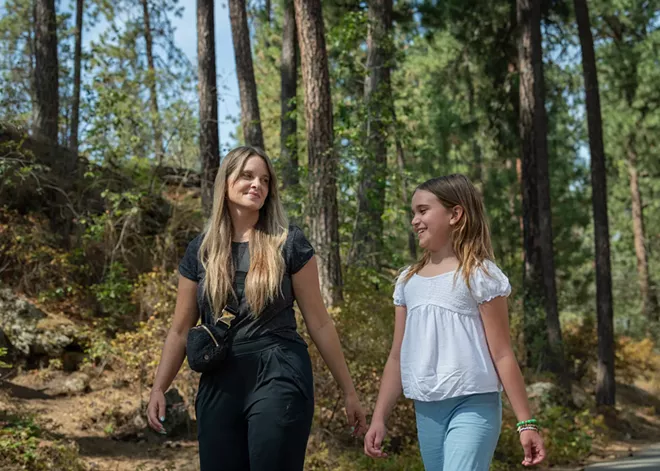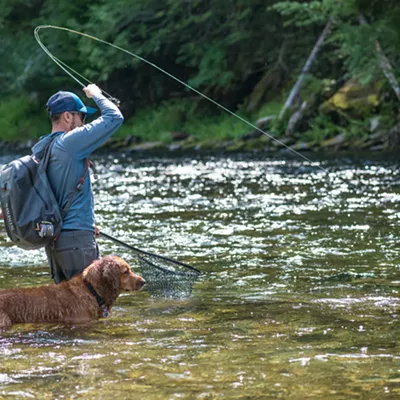
When a cartoonist draws a picture of someone reclining on a couch with a figure seated behind them, pen and notepad in hand, we all know that represents a therapy session. But contrary to stereotype, even Sigmund Freud, whose psychoanalysis practice helped popularize this image, wasn't always a fan of sedentary conversation.
In her book Walk and Talk Therapy: A Clinician's Guide to Incorporating Movement and Nature into Your Practice, clinical social worker and therapist Jennifer Udler recounts the time Freud took a cathartic four-hour stroll with the composer Gustav Mahler.
"Mahler was going through a very difficult time. His wife was cheating on him. He had all kinds of health problems. And after this walk, he composed at least the beginning of his 10th Symphony," she says.
"Sadly, he died before he finished composing it. But it speaks to the idea that we can process information, thoughts and feelings as we're walking. And we also have this element of bringing more creativity into ourselves when we're moving."
As the title of her book indicates, Udler is both a practitioner and advocate of what's commonly known as walk-and-talk therapy, an approach that swaps the office and the couch for the forest and the park bench. It's central to the work she does at Positive Strides Therapy, the Maryland-based practice that she founded more than a decade ago.
Walk-and-talk therapy, as she points out, is not a radical concept. Humans have been having ambulatory chats since the advent of language itself. In recent years, though, it's been gaining steam as a recognized and requested therapeutic modality, a trend that was likely accelerated by the public health precautions of the COVID-19 pandemic.
According to Udler, one reason for the increasing popularity of walk-and-talk therapy is its ability to create a more equitable relationship between therapist and client. Two individuals strolling side by side in a neutral outdoor space presents a very different mental image from the Freudian couch.
"It kind of takes the edge off," she says. "Clients don't see that power differential that you might see in an office setting. There's this feeling of, 'We're in this together.'"
The modality also taps into what Udler describes as "the healing power of nature."
"You wouldn't believe the things in nature that can be so helpful and supportive for people. Maybe they're dealing with grief and loss and see the flowers blooming in the spring, and they're like, 'Oh, it's a whole cycle.' Even the weather can parallel people's moods and make them feel comforted."
That anecdotal experience is supported by a 2020 study in the Clinical Psychology Review that found the advantages of "added mutuality, freedom of expression, mind-body holism, interconnectedness with the natural world, and practitioner well-being" when talking therapy took place in natural outdoor spaces.
Liberty Lake therapist Mary Ward, who lectures in the children's studies program at Eastern Washington University, echoes Udler's idea that nature can act as a "co-therapist." When she and her clients take to the trail or visit a park, Ward encourages them to tune into their surroundings in an almost meditative way.
"We'll do a lot of pausing and taking a breath and noticing what's around us, just connecting to where we're at in the present moment and how we feel," she says. For clients who might be dealing with depression or anxiety, this "built-in opportunity to practice mindfulness" can often bring added balance and calm to a session.
Ward has also seen clients of all ages, and particularly young children, respond well to the simple act of moving. The modest exercise involved in even a basic outing can be uplifting and imbue clients with a sense of accomplishment. Positive experiences like those motivated her to develop Walk Through It, a mental health intervention program designed for college campuses and based on the walk-and-talk modality.
"There's the release of endorphins that's going to instantly sort of boost your mood and energize you physically and mentally and emotionally. That can be really impactful when you have been stuck, [because] any kind of mental health issue can really affect your confidence," she explains.
For all its benefits, outdoor therapy does come with a few extra considerations. A common one is weather, which is solved by either dressing appropriately or moving that day's session indoors or to an online platform like Zoom.
A potentially trickier one is confidentiality. Both Udler and Ward say that conscientious walk-and-talk therapists should be upfront with their clients about the risk of being seen and have appropriate strategies in place to deal with it. Just as with a traditional indoor therapy session, the important thing is that the client feels safe and at ease.
"We really take it at their pace," Ward says. "My job as a therapist, and as a walk-and-talk therapist, is to meet you where you're at and get you to a place that feels comfortable."
WALK-AND-TALK FAQS
How did walk-and-talk therapy get its start?
It's hard to pinpoint a single, definitive origin for a practice that began quite casually. Many practitioners, including Jennifer Udler, cite Thaddeus Kostrubala's The Joy of Running (1976) as an influential consideration of exercise in relation to therapy.
Are the walks challenging?
They're only as challenging as you want them to be. Walk-and-talk therapists generally tailor their sessions to their clients — whether it's a short, relaxed stroll around a city park or a long ramble on a rural hiking trail. For exercise buffs, some therapists do cater to the more demanding side of the outdoor therapy spectrum, like jogging or even climbing.
Do you have to wear special clothes?
Not unless your preferred walking route calls for it. In most cases, your everyday casual attire is fine.
What if someone sees me walking with my therapist?
Inside or out, ethical therapists follow a code of conduct that maintains strict client confidentiality. That means they won't tell others what you've discussed or that you're even a client. Since they can't guarantee complete anonymity when you're outdoors, individual therapists often have a tool kit for gracefully handling those situations. If being spotted by someone you know is a sticking point, be sure to discuss the issue with your walk-and-talk therapist beforehand.
What happens in inclement weather like rain, show or excessive heat?
Simple! Just move that session indoors or online. Walk-and-talk therapy is usually framed as an alternative, not an all-or-nothing proposition. Provided your therapist is game, die-hards can also dress appropriately for the weather and continue their session outside.























